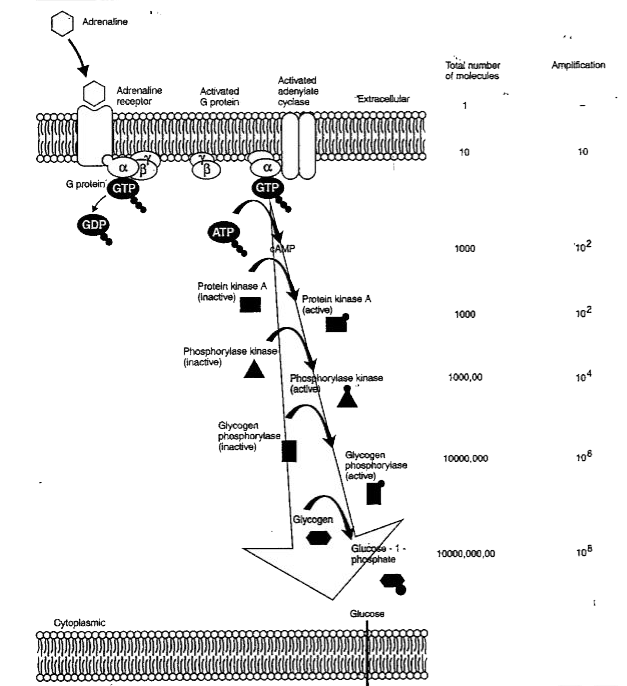Discuss the molecular mechanism of hormone action in animals.
Text Solution
All vertebrate hormones belong to one of four chemical groups:
I. First group : Some hormones, such as adrenaline and thyroid hormone, are small molecules deriyed from amino acid tyrosine
II. Second group: Vasopressin and oxytocin are short peptides.
III. Third group: Insulin and glucagons are longer polypeptide chains.
IV. Fourth group : Testosterone and estrogen are steroid hormones.
Catecholamines, peptide and protein hormones are not lipid soluble and so they cannot enter their target cells through the bilipid layer of plasma membrane. Instead these water soluble hormones interact with a surface receptor, usually ,a glycoprotein and thus initiate a chain of events within it. The hormone insulin provides example of how this happens.
The membrane receptors of insulin is a heterotetrameric protein having four subunits. Two a-subunits protrude out from surface of the cell and bind insulin. Two b-subunits span the membrane and protrude out into the cytoplasm. Such receptors range from fewer than 100 in most cells in our body to more than 1,00,000 in some liver cells. This mechanism can be described under following heading :
(i) Binding to the receptor :
1. When insulin binds to the outer subunits of the receptor then it brings a conformational change in membrane spanning b-subunits which is also an enzyme, a tyrosine kinase.
2. The activated b-subunits add phosphate group of specific tyrosine residues located in cytoplasmic domain of the receptor as well as a variety of insulin receptor substrates.
(ii) Second messengers-the mediator:
(a) Due to b-subunit activity a transducer G-protein, enzyme phosphodiesterase is activated.
(b) This enzyme i.e. phosphodiesterase make phosphatidylinositol 4, 5-biphosphate (PIP2) into a pair of mediators : inositoltri-phosphate (IP3) and diacyiglycerol (DG).
(c) In turn, IP3 which is water soluble and so diffuses into cytoplasm triggers the release of another chemical messenger Ca2+ ions from intracellular endoplasmic reticulum activating many calcium mediated processes.
(d) While DG, remains in the membrane where it activates an enzyme, such as pyruvate dehydrogenase and so brings about physiological effects.
(iii) Amplification of Signal.
(a) A single b-subunit of insulin receptor activates many molecules of DG.
(b) Each protein kinase C molecule activated by DG, will in turn activate many other enzyme molecules. DG and IP are examples of second messengers.
(c) A variety of hormones use another second messenger, the cyclic form of adenosine monophosphate (cAMP). The enzyme adenylate eylase converts enzyme adenosine triphosphate (ATP) into cAMP. A single molecule of active adenylate cyclase can catalyse production of about 100 molecules of cAMP.
(d)In muscle or liver cells, when hormones such as adrenaline bind receptors, the receptors change shape and bind to G-protein, causing it, in turn, to bind the nucleotide guanosine triphosphate (GTP)and activate another protein adenylate cyclase. The result of this complex cascade of interactions is the production of large amounts of cAMP.
(e) cAMP activates enzyme kinase A. Protein kinase activates enzyme phosphorylase kinase one hundred molecules. The net result is that a single molecule of adrenaline may lead to release of as many as 100 million molecules of glucose within only 1 or 2 minutes.
Antagonistic effect : Many cells use more than one second messengers.
Example 1. In heart cells, cAMP serves as a second messenger, speeding up muscle cell contraction in response to adrenaline, while cyclic guanosine monophosphate (CGMP) serves as another second messenger, showing muscle contraction in response to acetylcholine.
Example 2. Effect of sympathetic and parasympathetic nervous system on heartbeat is also an antagonistic effect: Sympathetic nervous system accelerates heart beat and parasympathetic nervous system lowers heart beat.
Example 3. Another example of antagonistic effect is insulin, which lowers blood sugar level, and glucagon, which raises it.
Synergistic effect: In this two or more hormones complement each other.s actions and both are needed for full expression of hormone effects. Examples:The production, secretion and ejection of milk by mammary glands require the synergistic effect of estrogen, progestrone, prolactin and oxytocin.
Intracellular Receptors
1. Steroid hormones are lipid soluble hormones and readily pass through the plasma membrane of a target cell into the cytoplasm.
2. There they bind to specific intracellular receptor proteins, forming a complex that enters the nucleus and bind to specific regulatory sites on chromosome.
3. The binding alters the pattern of gene expression, initiating the transcription of some genes (DNA), while repressing the transcription of others.
4. This results in the production of specific mRNA translation products, proteins and usually enzymes.
5. The actions of lipid-soluble hormones are slower and last longer than the action of water-soluble hormones.

|
Updated on:21/07/2023
Similar Questions
Knowledge Check
- Question 1 - Select One
Which of the following hormone represent the mechanism of hormone action shown in the given diagram?
 AEstrogenBProgesteroneCFSHDCortisol
AEstrogenBProgesteroneCFSHDCortisol
Which of the following hormone represent the mechanism of hormone action shown in the given diagram?
 View Solution
View SolutionCompare and contrast nervous and hormonal mechanisms for control and coordination in animals.
View SolutionCompare and contrast nervous and hormonal mechanisms for control and coordination in animals.
View SolutionFind the incorrect statement w.r.t. mechanism of hormone action
View Solutionfind the incorrect statement w.r.t. mechanism of hormone action
View SolutionExplain the mechanism of action of enzyme.
View SolutionDescribe the mechanism of action of antibiotics.
View Solution

